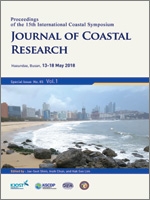Wang, L.; Jiang, Q.; Nie, S.; Zhang, J., and Iddy, I., 2018. Improvement on MPS method for simulation of dynamic pressure in dam break flows. In: Shim, J.-S.; Chun, I., and Lim, H.S. (eds.), Proceedings from the International Coastal Symposium (ICS) 2018 (Busan, Republic of Korea). Journal of Coastal Research, Special Issue No. 85, pp. 971–975. Coconut Creek (Florida), ISSN 0749-0208.
The obvious unphysical pressure fluctuation is a serious issue when the original MPS method is used for the simulation of a violent flow problem, such as dam break flow. In this study, some modifications on the original MPS method are proposed to decrease the unreasonable pressure biases, in which a simple and effective auxiliary criterion for free surface particles is proposed to increase the accuracy of surface representation, and a new form of source term is implemented in the pressure Poison equation. The improved MPS model is applied to simulate the dam break flows so as to examine the effectiveness of the proposed methods on the improvement of dynamic pressure calculation. Comparisons with the experimental results for the dam break flow verified that the new free surface detection method is effective to avoid the misrecognition of free surface particles. Meanwhile, through examining the calculated pressure histories at a fixed point with different forms of source term, the importance of the source term of pressure Poison equation in the calculation of the dynamic pressure is demonstrated.





